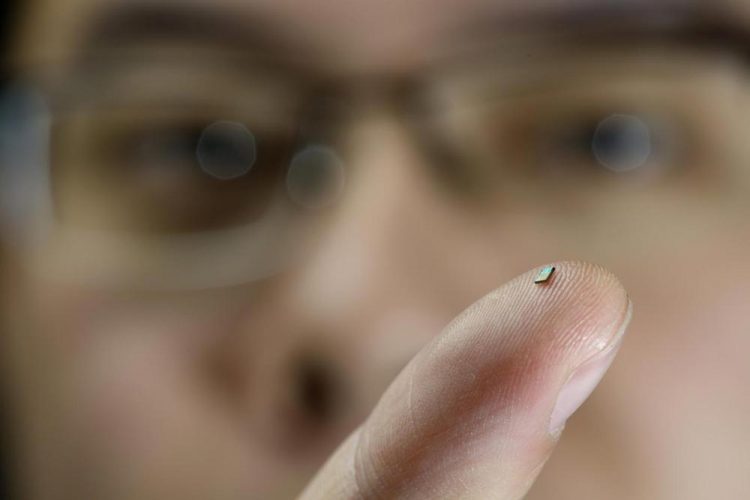The world's tiniest temperature sensor is powered by radio waves

The tiny temperature sensor is on the finger tip of Ph.D.-student Hao Gao of Eindhoven University of Technology. Credit: Bart van Overbeeke/Eindhoven University of Technology.
This means that the sensor needs not even a single wire, nor a battery that would have to be replaced. The arrival of such sensors is an important development on route towards smart buildings, for instance. But the applications are many and various.
The smart buildings of the future will be full of sensors that will respond to the residents' every need, and will be as sustainable as possible. Like heating and lighting that only switches on when someone is in the room. That's only possible if these sensors are wireless and need no batteries, otherwise in a large building you would have to change the batteries every day.
This is demonstrated by TU/e researcher Hao Gao who will be awarded his PhD on Monday 7 December for his thesis in which he developed a sensor that measures just 2 square millimeters and weights a mere 1.6 milligrams, equivalent to a grain of sand.
The current version of the sensor has a range of 2.5 centimeters; the researchers expect to extend this to a meter within a year, and ultimately to 5 meters. The sensor has a specially developed router, with an antenna that sends radio waves to the sensors to power them. Since this energy transfer is accurately targeted at the sensor, the router consumes very little electricity.
And the sensors themselves are made such that their energy consumption is extremely low. The sensor also operates beneath a layer of paint, plaster or concrete. As Peter Baltus, TU/e professor of wireless technology, explains, this makes the sensor easy to incorporate in buildings, for instance by 'painting' it onto the wall with the latex.
The sensor contains an antenna that captures the energy from the router. The sensor stores that energy and, once there is enough, the sensor switches on, measures the temperature and sends a signal to the router. This signal has a slightly distinctive frequency, depending on the temperature measured. The router can deduce the temperature from this distinctive frequency.
The same technology enables other wireless sensors to be made, for example to measure movement, light and humidity. The application areas are enormous, Baltus says, ranging from payment systems and wireless identification to smart buildings and industrial production systems. They won't be expensive either: mass production will keep the cost of a sensor down to around 20 cents. The sensor is based on 65-nm CMOS technology.
The project, called PREMISS, has received funding from the STW technology foundation. The title of Hao Gao's thesis is 'Fully Integrated Ultra-Low Power mm-Wave Wireless Sensor Design Methods'. The integrated circuits research was done in the Mixed-Signal Microelectronics group and also involved the TU/e groups Electromagnetics and Signal Processing Systems as well as the Center of Wireless Technology.
Media Contact
All latest news from the category: Information Technology
Here you can find a summary of innovations in the fields of information and data processing and up-to-date developments on IT equipment and hardware.
This area covers topics such as IT services, IT architectures, IT management and telecommunications.
Newest articles

Recovering phosphorus from sewage sludge ash
Chemical and heat treatment of sewage sludge can recover phosphorus in a process that could help address the problem of diminishing supplies of phosphorus ores. Valuable supplies of phosphorus could…

Efficient, sustainable and cost-effective hybrid energy storage system for modern power grids
EU project HyFlow: Over three years of research, the consortium of the EU project HyFlow has successfully developed a highly efficient, sustainable, and cost-effective hybrid energy storage system (HESS) that…

After 25 years, researchers uncover genetic cause of rare neurological disease
Some families call it a trial of faith. Others just call it a curse. The progressive neurological disease known as spinocerebellar ataxia 4 (SCA4) is a rare condition, but its…





















